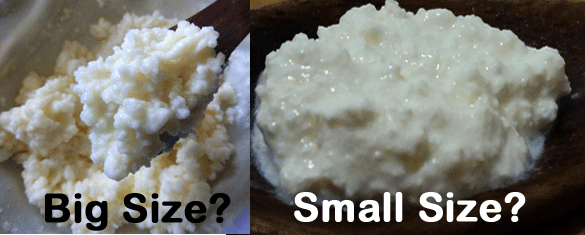Although milk kefir grains often multiply, nobody can necessarily guarantee that they will multiply in a similar pattern in every given atmosphere or sometime it may gradually disappear within few days. The growth ultimately depends on mainly on culturing environment, quality of milk (chemical or antibiotic free milk), climatic conditions, room temperature, milk fat & lactose content, hygiene, glass jar shape, quantity of milk used for each fermentation, proportion of kefir grains and milk, etc..
Also, do we need to worry if your Kefir Grains are smaller in size (like large sand)?
The common reason for milk kefir grains to break down or reduce in size or disappearing can be due to stress conditions like harsh temperature, malnourishment, rough handling, and processed or low quality milk.
The main drawback of small sized kefir grains is the effort involved in separating kefir grains from the fermented milk. The small grains mix with the milk solid and fat and gets tedious to separate them. Secondly, the kefir grains growth also dwindles and smaller ones slip through the strainer. This will result in disappearing of the kefir grains in subsequent batches.
We have given some important tried and tested recommendations for growing healthy kefir grains in this page.
The following recommendations will give you more ideas to keep your kefir grains happy and also growing in quantity.
-
Optimum temperature or climatic condition
The kefir grains loves a soothing temperature between 22°C to 25°C Degree. This is the best temperature for them to grow well (even in size). If the temperature goes below 22°C, their growth becomes slightly sluggish. If the temperature goes more than 25°C, they get stressed and may break down to smaller size. Here, we would recommend to place the jar in suitable room with ideal temperature as suggested.
People who stay in cold places below 22°C, please try to place the culture jar in the kitchen table top area (away from stove) where it is warm.
People who stay in warm geographical locations (above 25°C), place the fermenting jar in relatively cold rooms (except bathrooms) in your house. Also, you can give a try by placing the jar in big bowl of cool water and be careful by not submerging it. Important note, you will have to change the water daily and clean the bottom bowl or plate regularly, it may develop mold, spread and contaminate kefir within the jar.
-
Feed with good quality organic cows milk and increase the frequency
Please keep in mind, the kefir grains uses the milk substance (mainly lactose) to grow new kefir grains. Identify the ORGANIC & unadulterated full fat milk to encourage the growth of the grains. If the dairy milk may have residual anti-biotics it inhibits the kefir grains growth and slowly disappears. Try different brand dairy milk (sachet milk, but avoid UHT or ultra-pasteurized milk) if you see kefir grains are reducing.
We suggest to use desi cow’s milk, we found it best. You can also use buffalo milk, but it turns very creamy due to excess cream, and it becomes difficult to separate the grains and kefir milk after fermentation.
Once the fermentation is done, the kefir grains needs new batch of milk, so increase the frequency of changing milk to keep them healthy.
Remember, if the quantity of kefir grains are more, you should feed more milk proportionately or it will be underfed.
-
Place the jar in well ventilated room.
The fermentation needs good flow of fresh air and air exit. The kefir grains growth is directly related to availability of proper ventilation in aerobic fermentation (covered with cloth).
-
Choose a best jar, with wide mouth and a large base.
Use a shallow wide container to ferment kefir milk. This will facilitate each of the grains to rest down and feed on the milk instead of clumping up at the top of a narrow jar.
-
Keep the grains smaller in quantity.
You can divide the kefir grains to different bottles and feed more milk, this will help grains to avail more nutrients in the milk.
-
Don’t use soap or chemicals
Do not wash the utensils, jar or strainer with soap or dish wash. This will harm the kefir grains survival and growth. Use hot water to wash the utensils and cool down before use.
-
Do not wash the kefir grains
If you are washing or rinsing the kefir grains with water while straining to ease your work, you are actually retarding the activity of kefir grains or stripping the micro organisms from the surface of the grains. Rinsing slowly deteriorates the quality of kefir grains, and slowly contributes for disintegration of grains.
-
Use double fine mesh
In the single mesh, the smaller grains will escape, so it is recommended to use double mesh strainer to not loose grains. If you are using single mesh, avoid the use of spoon/spatula to separate. Just tap the strainer to release finished creamy kefir from the kefir grains.
-
Fresh cream treat
Once in a while add around 1/2 cup of fresh milk cream to 500 ml milk and give a treat to milk kefir grains. Also, your milk kefir drink will be creamy and tasty.
To conclude, we should always remember milk kefir grains are living things, consisting of good bacteria’s and yeast, they need to be carefully handled and fed with good amount of feed (organic and full fat milk on frequent basis) to be nurtured, reproduce and stay healthy.

